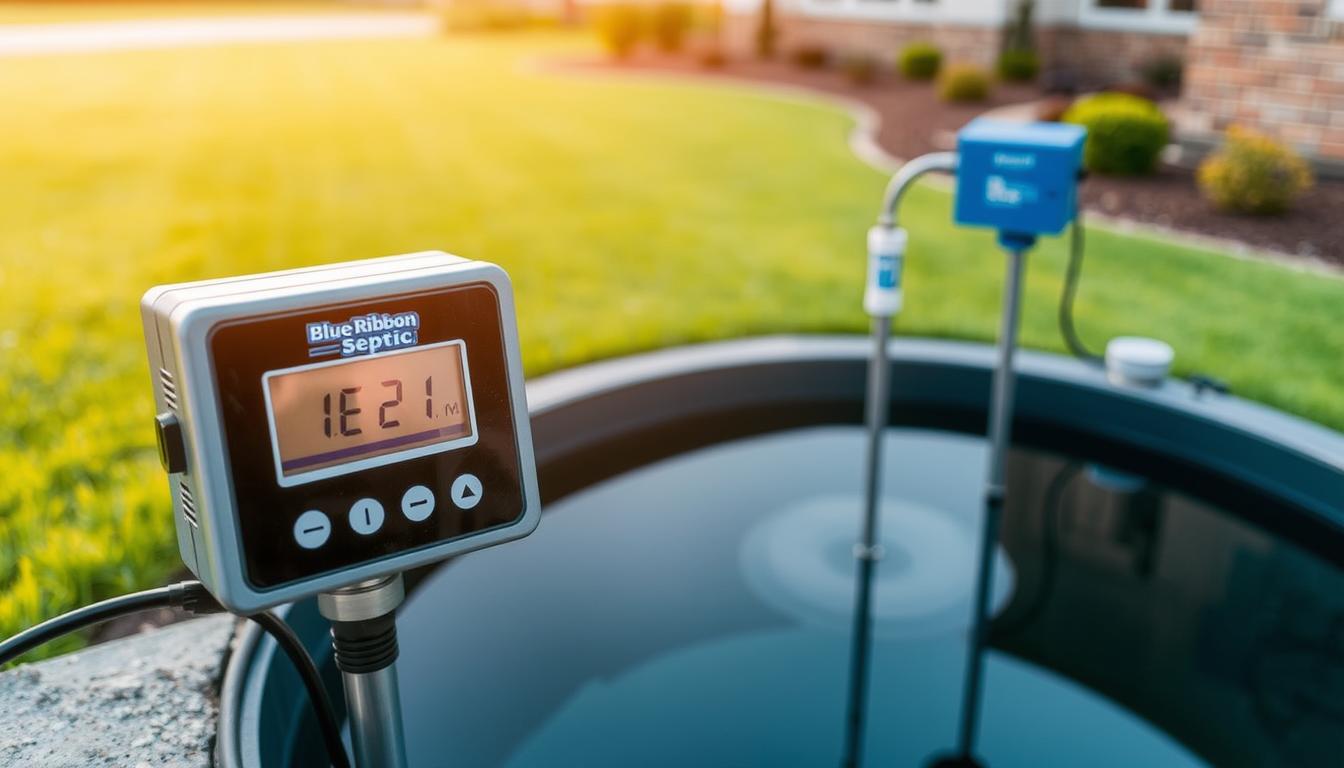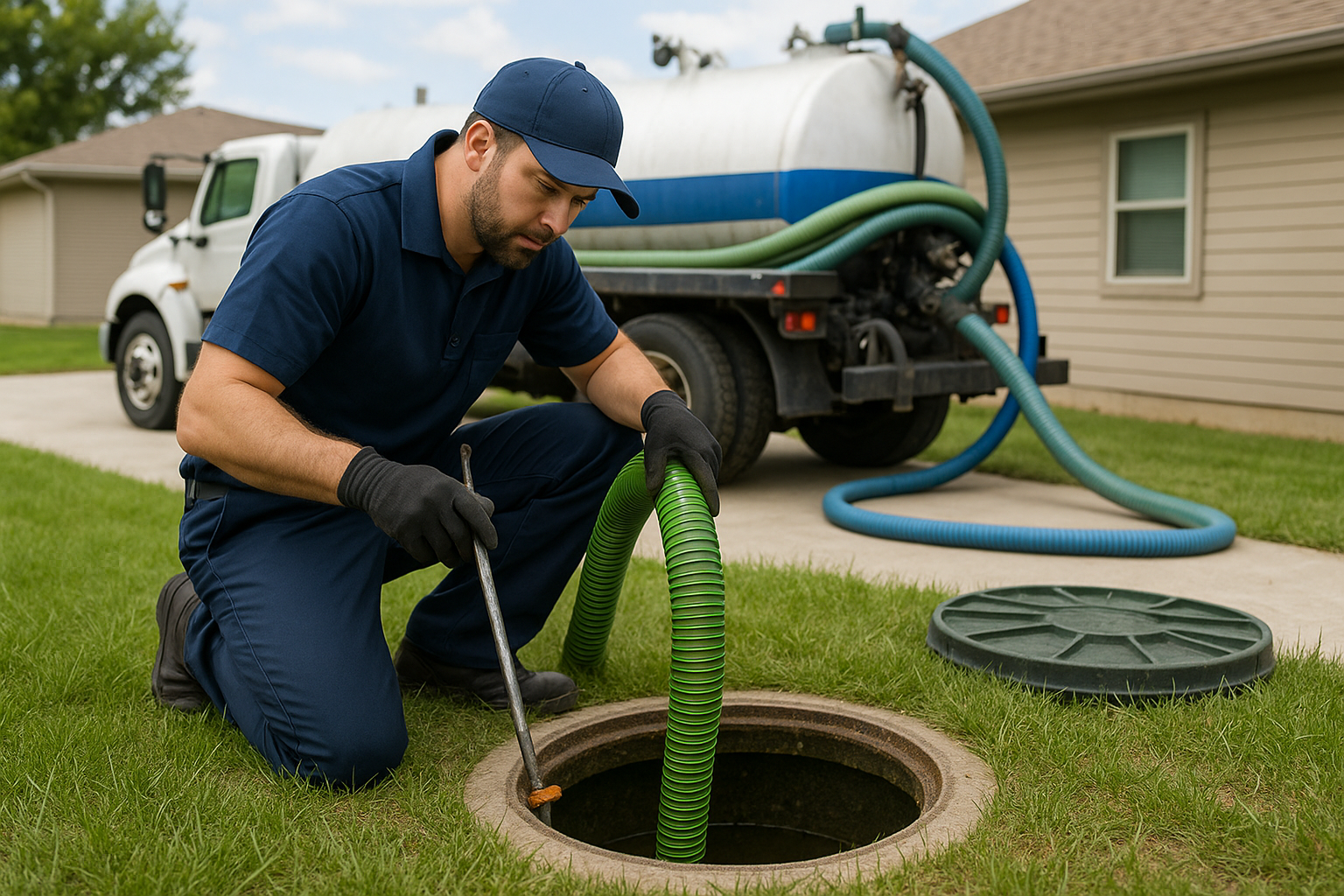Keeping your septic system healthy is key for homeowners, mainly those in rural areas. These areas often lack municipal sewage systems. A septic tank level indicator or septic level sensor is vital. It warns you when the waste in your septic tank gets too high. This helps avoid system failures and environmental dangers.
Getting a septic tank monitoring system is a smart move. It makes sure your septic system works well, cutting down on expensive fixes and pollution. It also keeps you informed about when to do maintenance, like inspections and tank pumping.
Key Takeaways
- Regular monitoring of your septic system is key to avoiding failures and environmental problems.
- A septic tank level indicator or septic level sensor alerts you to high waste levels, helping you stay on top of maintenance.
- Investing in a septic tank monitoring system can reduce the risk of costly repairs and environmental contamination.
- Proper maintenance includes scheduling regular inspections and pumping the tank when necessary.
- A well-maintained septic system operates efficiently and effectively, protecting your home and the environment.
The Critical Role of Septic System Monitoring
Monitoring your septic system is key to avoiding failures and keeping the environment safe. Your septic system is a complex system that needs regular checks to work right.
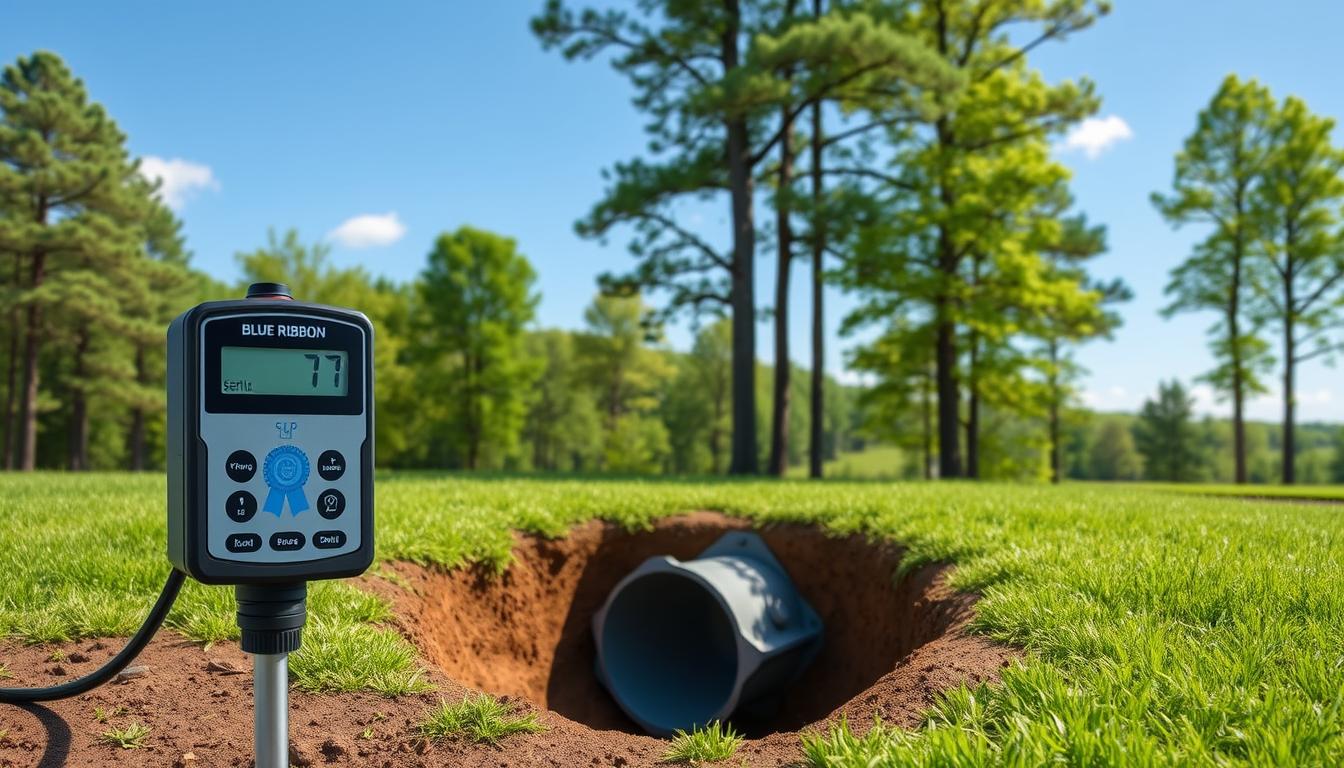
How Septic Systems Function
A septic system collects wastewater from your home in a tank. Here, solids and liquids separate. The liquid then goes to a drain field for filtering and treatment by the soil. It all depends on a balance between the tank, drain field, and nature.
Common Septic System Failures
Failures can happen due to neglect, bad design, or outside factors like heavy rain. Issues include backups, slow drains, and contamination. Regular checks can spot problems early.
As a homeowner, knowing the signs of failure is important. Look out for:
- Slow draining sinks and toilets
- Backups or overflows
- Lush vegetation over the drain field
- Unpleasant odors around the property
The Cost of Neglecting Your System
Ignoring your septic system can cost a lot. It can lead to expensive fixes, health risks, and harm to the environment. Being proactive can save you money and protect your property.
"Regular maintenance and monitoring of septic systems are key to avoid failures, which can cause expensive repairs and harm the environment."
Understanding the importance of monitoring your septic system is vital. By taking action, you can keep your system working well and safely.
What Is a Septic Tank Level Indicator and Why You Need One
A septic tank level indicator is a key tool for homeowners. It lets you keep an eye on your septic system. You get real-time info on the wastewater level, helping you act fast to avoid problems.
Definition and Core Functions
A septic tank level indicator or septic tank monitoring device tracks the wastewater in your tank. It uses sensors to check the liquid level and alerts you when it's high. Its main job is to warn you before your tank overflows.

How Level Indicators Prevent System Failure
With a wastewater level gauge, you can dodge the high costs of septic system failures. These failures happen when the tank is too full, leading to backups or overflows. A level indicator tells you when it's time to pump the tank, stopping failures before they start.
Return on Investment for Homeowners
Getting a septic tank level indicator costs money upfront. But, the long-term savings are huge. It saves you from expensive fixes and keeps your environment safe. Plus, a well-kept septic system can boost your home's value.
In short, a septic tank level indicator is more than useful; it's vital for keeping your septic system in top shape. It saves you money, gives you peace of mind, and protects your property's value.
Warning Signs That Your Septic System Needs Monitoring
Knowing the signs of a failing septic system is key for homeowners. It helps avoid expensive fixes. Your septic system works quietly, but some signs can show problems early.
Slow Drains and Backups
Slow drains in sinks, toilets, or showers mean your septic system might be overloaded. Slow drains and backups are often the first indicators that something is amiss. Catching these issues early is possible with regular checks.
Unusual Odors Around Your Property
Bad smells near your home, like near the drain field or septic tank, mean trouble. A strong, persistent sewage smell is not normal and should be investigated.
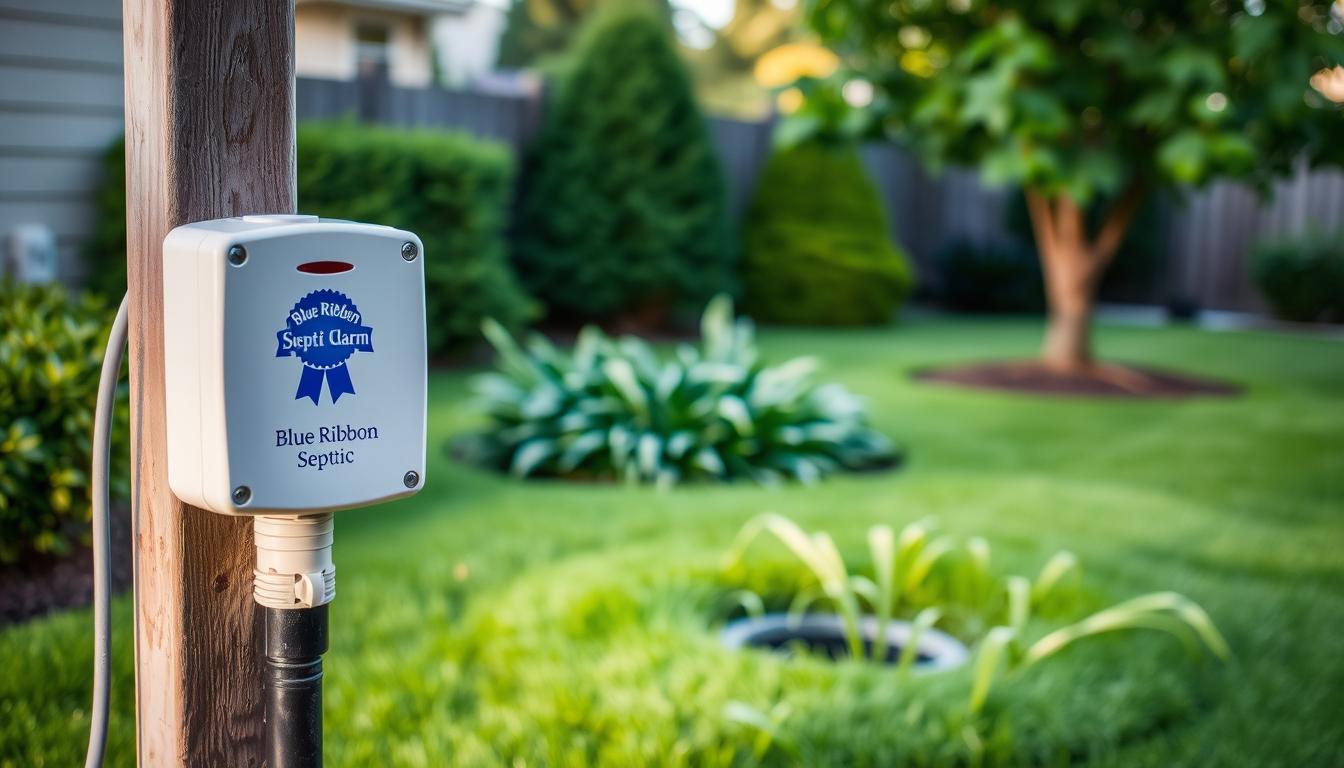
Lush Vegetation Over the Drain Field
While a green lawn is nice, too much green over your drain field is a bad sign. It means your septic system is leaking nutrients into the soil. This could mean your drain field is failing.
Previous System Failures
Experiencing septic system failures before means you need to watch it closely. Previous failures can be a predictor of future issues. Keeping an eye on your system's performance is vital.
Being aware of these signs and using a septic tank alarm or sewage tank level detector helps. You can then take steps to keep your system healthy and avoid expensive problems.
Types of Septic Tank Level Indicators Available Today
It's important to know about the different septic tank level indicators. With new tech, there are many ways to keep an eye on your septic system.
Mechanical Float Switches
Mechanical float switches are a common choice. They work with a float that moves up and down with the tank's liquid level. This triggers an alarm when the level gets too high. They're simple and reliable.
Advantages: These switches are affordable and simple to set up. They make it easy to check the tank's level.
Pressure Transducer Systems
Pressure transducer systems measure the tank's liquid pressure. This pressure shows the liquid level, giving accurate readings. They're reliable and work with many tank types.
Key Benefit: These systems are very accurate. They can fit different septic tanks, making them versatile.
Ultrasonic and Sonic Sensors
Ultrasonic and sonic sensors use sound waves to find the liquid surface. They're easy to install and give precise readings.
Advantages: Ultrasonic sensors don't touch the tank, which helps them last longer. They're also easy to keep up.
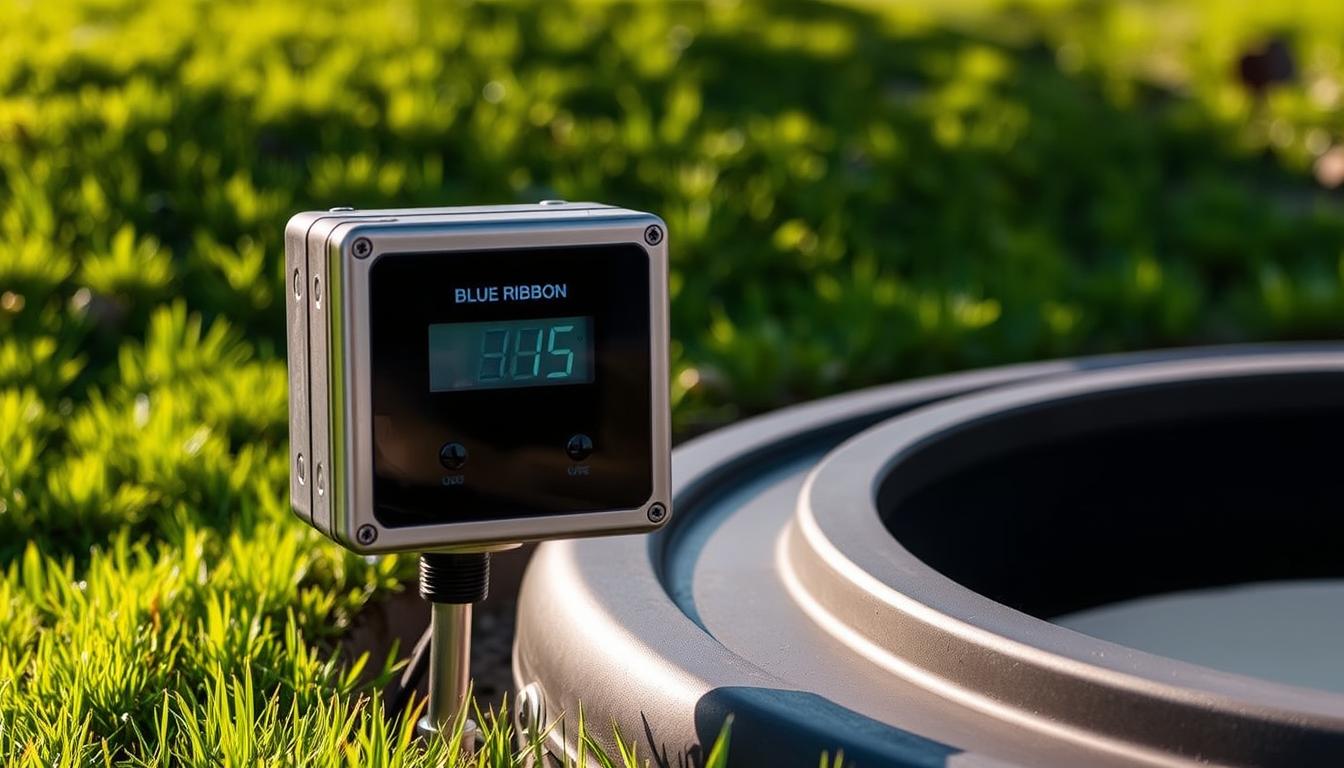
Optical Sensors
Optical sensors use light to measure the liquid level. They're very accurate and used where precision matters.
Key Feature: Optical sensors give real-time data. They're also good at avoiding interference, perfect for complex systems.
Smart Monitoring Technologies
Smart septic monitoring lets you check your tank levels from anywhere. These systems can also send alerts for high water or system problems.
Benefits: Smart monitoring is convenient. It lets you monitor in real-time and get alerts. This makes managing your septic system easier.
Key Features to Look for in a Quality Septic Tank Level Indicator
Choosing the right septic tank level indicator is key. You want a system that works well and doesn't break the bank. A good septic monitoring device keeps your tank in check and saves you from expensive repairs.
Accuracy and Measurement Range
The accuracy of your septic tank level indicator matters a lot. Look for devices that measure your tank's full capacity accurately. Some might give better readings than others, like in tanks with complex shapes or multiple parts.
Alarm Systems and Alert Methods
A good alarm system is essential. Choose indicators with customizable alerts and various ways to notify you, like SMS or email. This way, you'll know right away if there's a problem with your tank.
Wireless and Remote Monitoring Capabilities
Wireless monitoring makes things easier. It lets you check your tank levels from anywhere. This means you can spot issues fast without having to physically check the tank.
Weather Resistance and Durability
Your septic tank level indicator needs to handle the weather. Look for sturdy, weather-resistant devices. They should last a long time, even in tough weather.
Power Source Options and Battery Life
Think about how your device will get power. Some use batteries, while others need to be plugged in. Check how long the battery lasts and how easy it is to replace or recharge.
By focusing on these features, you can find a septic tank level indicator that fits your needs. Whether you need something simple or a full-featured wireless system, knowing what to look for will help you make the right choice.
Top Septic Tank Level Indicator Products for Homeowners
Homeowners looking to keep an eye on their septic systems have many options. From affordable to high-end systems, picking the right one can be tough. This guide will help you find the best septic tank level indicators, sorted by price and tank type.
Budget-Friendly Options Under $200
For those on a budget, there are several cheap septic tank level indicators. These include:
- The Simple Septic Alert, a basic float switch system that provides reliable level monitoring at an affordable price.
- The Septic Sentinel, an ultrasonic sensor-based system that offers accurate measurements without breaking the bank.
These options are perfect for those who want to keep their septic system in check without spending a lot.
Mid-Range Solutions ($200-$500)
For those ready to spend a bit more, mid-range options offer better features and reliability. Notable products in this category include:
- The SepticPro system, which combines a pressure transducer with a wireless alert system for timely notifications.
- The SmartSeptic Monitor, featuring advanced data logging and remote access capabilities.
These mid-range solutions offer a good balance of cost and functionality, giving homeowners solid monitoring capabilities.
Premium Monitoring Systems ($500+)
Premium septic tank level indicator systems are the most accurate and reliable. Examples include:
- The SepticGenius system, which integrates multiple sensors for complete monitoring and alerts.
- The Advanced Septic Monitoring System, featuring AI-powered predictive maintenance and detailed analytics.
Though pricier, these systems offer peace of mind and can save money in the long run by avoiding costly septic failures.
Best Systems for Different Tank Types
The type of septic tank you have affects the choice of level indicator. For example:
- For concrete tanks, robust and durable sensors like the Concrete Tank Sensor are recommended.
- For plastic or fiberglass tanks, more adaptable and corrosion-resistant options such as the Universal Septic Sensor are suitable.
It's key to pick a septic tank level indicator that fits your tank type for accurate and reliable monitoring.
DIY vs. Professional Installation Considerations
Choosing between DIY and professional installation for your septic tank level indicator is key. It affects how well your system works and lasts. Your skills, the system's complexity, and your budget play big roles in this choice.
Skills and Tools Required for DIY Installation
To install it yourself, you need basic plumbing skills and the right tools. You'll need a drill, pipe cutters, and maybe a ladder to reach the tank. Make sure you know your septic system's layout well to avoid damage.
When Professional Installation Is Recommended
Go for professional help if you're not sure about the process or if your system is complex. Complex systems might have multiple tanks or unusual setups. They need special knowledge for the level indicator to work right.
Cost Comparison Between DIY and Professional Services
DIY installation is cheaper, mainly because you save on labor costs. But, professional installation might cost more. It ensures your system is set up correctly, which could save you money in the long run.
- DIY costs: Device cost + your time
- Professional costs: Labor + device cost + possible warranty benefits
Finding Qualified Installers in Your Area
To find a good installer, ask local septic experts for recommendations or look up online reviews. Make sure the installer knows about septic tank level indicators and can give you references.
Step-by-Step Installation Guide for Septic Tank Level Indicators
To keep your septic system running well, follow this guide to install a septic tank level indicator. It will show you the steps, tools, and precautions needed for a successful installation.
Safety Precautions Before You Begin
Start by taking safety steps. Always wear protective gear like gloves and safety glasses. Make sure the area around the septic tank is well-ventilated to avoid harmful gases.
Tools and Materials Checklist
Before you start, make sure you have all the tools and materials. You'll need:
- A septic tank level indicator device
- Mounting hardware (if required)
- Power source (batteries or wiring)
- Any additional sensors or accessories
Check your device's manual for a detailed list of what you need.
Locating the Optimal Sensor Position
The sensor's position affects the accuracy of your septic tank level indicator. Typically, the sensor should be placed near the top of the tank or at a level that triggers the alarm. Look at your system's documentation for the best placement.
Installation Process by Indicator Type
Installation steps vary based on the type of septic tank level indicator. For example:
- Mechanical Float Switches: Attach a float to a rod that activates a switch at a certain level.
- Ultrasonic and Sonic Sensors: Mount above the tank and align with the liquid surface.
- Pressure Transducer Systems: Submerge a probe into the tank.
Follow the manufacturer's instructions for your specific device's installation.
Testing Your New System
After installing, test your septic tank level indicator to make sure it works. Check that it accurately shows the liquid level and that alarms work as they should. Regular testing keeps your system reliable.
Integrating Your Septic Monitoring System with Smart Home Technology
Smart septic monitoring is changing how we manage our septic systems. It connects them with smart home platforms. This makes monitoring easier, more convenient, and gives you peace of mind.
Compatible Smart Home Platforms
You can link your septic monitoring system with many smart home platforms. Amazon Alexa, Google Home, and Apple HomeKit are popular choices. They let you control and check your septic system with voice commands or apps.
Setting Up Mobile Alerts and Notifications
One big advantage of smart home integration is getting mobile alerts and notifications. You can set alerts for things like high water levels or system failures. This way, you're always in the loop.
Data Logging and History Tracking
Smart septic monitoring systems keep a record of your system's performance over time. This data helps you spot trends and issues early on. It's a great way to stay ahead of problems.
Advanced Automation Possibilities
With smart home integration, you can automate many septic system tasks. For example, you can set up automatic pump activations or maintenance alerts. This makes managing your system more efficient.
By linking your septic monitoring system with smart home tech, you get a better management experience. It boosts your monitoring abilities and helps you stay proactive with maintenance and troubleshooting.
Maintenance and Care for Your Septic Tank Level Indicator
To keep your septic system running smoothly, regular maintenance is key. A well-maintained septic tank level indicator is vital. It helps monitor your septic system's health and prevents failures.
Recommended Inspection Schedule
Regular checks are important for your septic tank level indicator. It's best to inspect it every 3 to 6 months. This depends on how much you use it and the manufacturer's advice. Look for damage, corrosion, or any signs of malfunction during these checks.
Cleaning and Calibration Procedures
Cleaning and calibration are essential for your septic tank level indicator. For cleaning, use a soft cloth or brush to remove debris. Avoid harsh chemicals that could harm the sensor. Calibration should be done every 6 to 12 months, as per the manufacturer's instructions.
Sensor Replacement Guidelines
The sensor in your septic tank level indicator may need to be replaced over time. Look for signs like inaccurate readings, frequent false alarms, or visible damage. Check your manufacturer's guidelines for when and how to replace it.
Winterizing Your Monitoring System
In cold climates, you need to winterize your septic monitoring system. This prevents damage from freezing. You might need to insulate the sensor, drain condensate, or use a freeze-resistant sensor. For specific advice, refer to your system's documentation or talk to a professional.
By following these maintenance tips, your septic tank level indicator will stay in top shape. This ensures you get accurate and reliable info about your septic system's status.
Troubleshooting Common Septic Tank Indicator Problems
Septic tank level indicators are usually reliable but can face problems. Knowing how to fix these issues helps keep your septic system healthy.
False Alarms and Their Causes
False alarms from your septic tank level indicator can be annoying. They often happen because of debris on the sensor or wrong alarm settings. First, clean the sensor as the maker suggests. Then, check if your alarm settings match your system's needs.
Connectivity Issues with Wireless Systems
Wireless septic tank level indicators might have connectivity problems. This can cause lost data or false alerts. To fix it, check the signal strength. Try moving the receiver or reducing interference from other devices. If it doesn't work, replace batteries or follow the user manual.
Sensor Failures and Diagnostics
Sensor failure is serious and needs quick action. First, check the power, look for damage, and make sure it's calibrated right. If it's broken, you might need a new one. For help, look at your system's manual or call a pro.
When to Call for Professional Help
If you've tried fixing it and it's not working, it's time to call a pro. Look for signs like constant false alarms, lost signal, or sensor failure. Experts can find and fix complex problems, or suggest upgrades.
By tackling these common problems, your septic tank level indicator will work right. This gives you peace of mind and keeps your septic system healthy.
Cost-Benefit Analysis: The Economics of Septic Monitoring
Homeowners need to understand the cost-benefit of septic monitoring. A septic tank level indicator can help avoid expensive failures. It also makes your system last longer.
Initial Investment Breakdown
The cost of a septic tank level indicator varies. It depends on the technology and installation complexity. On average, it costs between $200 and $1,000. This might seem high, but think about the long-term savings.
Long-term Maintenance Costs
Even with monitoring, regular maintenance is needed. But, the costs are lower. Early detection of issues means fewer expensive repairs.
Savings from Preventing Major Septic Failures
Septic monitoring can prevent major failures. These failures can cost $1,000 to $10,000 or more. A monitoring system helps avoid these high costs.
Potential Impact on Property Value
A well-maintained septic system can boost your property's value. Buyers prefer homes with reliable septic systems. This can increase your home's value.
In summary, while there's an initial cost for a septic tank level indicator, the long-term savings and property value increase make it a wise choice for homeowners.
Environmental and Health Benefits of Proper Septic Monitoring
Septic monitoring is key for more than just your property. It helps protect the environment and our health. It stops many dangers from bad septic systems.
Preventing Groundwater Contamination
Septic monitoring stops groundwater pollution. Bad septic systems can pollute water, harming local sources. Regular checks catch problems early.
Protecting Local Watersheds
Monitoring septic systems keeps watersheds safe. It stops untreated waste from getting into streams and lakes. This keeps ecosystems healthy and supports wildlife.
Reducing Public Health Risks
Good septic monitoring cuts down health risks. Bad systems can spread diseases through soil and water. Early action prevents these problems.
Supporting Sustainable Wastewater Management
Monitoring helps manage wastewater better. It makes septic systems work well, reducing harm to the environment. Benefits include:
- Less pollution
- Healthier communities
- Stronger ecosystems
Conclusion: Protecting Your Home with Proactive Septic Monitoring
Proactive septic monitoring is key to keeping your home and the environment safe. It helps avoid the dangers of septic system failures. With a septic tank level indicator, you get early warnings of problems, lower maintenance costs, and better home protection.
A septic tank level indicator shows your system's status in real-time. This lets you act fast if something goes wrong. It keeps your property safe and helps the environment by stopping groundwater pollution and protecting local watersheds.
Investing in a good septic tank level indicator and smart home tech ensures your system works well. Regular checks and monitoring mean you can relax, knowing your home and the environment are safe.
FAQ
What is a septic tank level indicator, and how does it work?
A septic tank level indicator watches the liquid level in your septic tank. It alerts you when it gets too high. It uses sensors like float switches or ultrasonic sensors to measure the level and send signals to an alarm.
Why do I need a septic tank level indicator?
A septic tank level indicator stops system failures by warning you early. It also helps keep your septic system running well. This reduces the chance of expensive repairs and protects the environment.
What are the warning signs that my septic system needs monitoring?
Look out for slow drains, strange smells, and green plants over the drain field. If you see these signs, think about getting a septic tank level indicator.
What types of septic tank level indicators are available?
There are many types, like mechanical switches, pressure systems, and ultrasonic sensors. Each has its own benefits and uses.
How do I choose the right septic tank level indicator for my system?
Think about accuracy, alarm systems, and if it can be wireless. Also, consider durability and power source options. Pick one that matches your tank, budget, and needs.
Can I install a septic tank level indicator myself?
Yes, you can try to install it yourself. But, it's safer to hire a pro if you're not sure or lack the skills. A pro will set it up right and safely.
How do I maintain my septic tank level indicator?
Check it often, clean it when needed, and replace sensors as the maker says. Also, make sure it's ready for winter. This keeps it working well.
What are the benefits of integrating my septic monitoring system with smart home technology?
Integrating it with smart home tech gives you mobile alerts and data logging. It also adds advanced automation. This makes monitoring easier and more convenient.
How much does a septic tank level indicator cost?
Prices vary based on the device's type and features. Basic ones cost under $200, while advanced ones can be over $500.
Will a septic tank level indicator increase my property value?
Yes, a well-kept septic system with a monitoring device can make your property more valuable. It's a selling point.
What are the environmental benefits of proper septic monitoring?
Good septic monitoring stops groundwater pollution and protects watersheds. It also lowers public health risks and supports green wastewater management.
How does a septic tank level indicator prevent system failures?
It alerts you to high liquid levels, so you can pump the tank. This stops overflows and system failures.

